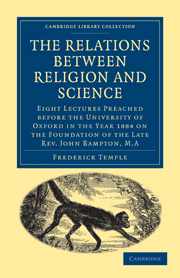 The Relations between Religion and Science
The Relations between Religion and Science Book contents
- Frontmatter
- Contents
- LECTURE I THE ORIGIN AND NATURE OF SCIENTIFIC BELIEF
- LECTURE II THE ORIGIN AND NATURE OF RELIGIOUS BELIEF
- LECTURE III APPARENT CONFLICT BETWEEN SCIENCE AND RELIGION ON FREE-WILL
- LECTURE IV APPARENT CONFLICT BETWEEN RELIGION AND THE DOCTRINE OF EVOLUTION
- LECTURE V REVELATION THE MEANS OF DEVELOPING AND COMPLETING SPIRITUAL KNOWLEDGE
- LECTURE VI APPARENT COLLISION BETWEEN RELIGION AND THE DOCTRINE OF EVOLUTION
- LECTURE VII APPARENT COLLISION OF SCIENCE WITH THE CLAIM TO SUPERNATURAL POWER
- LECTURE VIII THE CONCLUSION OF THE ARGUMENT
LECTURE VII - APPARENT COLLISION OF SCIENCE WITH THE CLAIM TO SUPERNATURAL POWER
Published online by Cambridge University Press: 29 August 2010
- Frontmatter
- Contents
- LECTURE I THE ORIGIN AND NATURE OF SCIENTIFIC BELIEF
- LECTURE II THE ORIGIN AND NATURE OF RELIGIOUS BELIEF
- LECTURE III APPARENT CONFLICT BETWEEN SCIENCE AND RELIGION ON FREE-WILL
- LECTURE IV APPARENT CONFLICT BETWEEN RELIGION AND THE DOCTRINE OF EVOLUTION
- LECTURE V REVELATION THE MEANS OF DEVELOPING AND COMPLETING SPIRITUAL KNOWLEDGE
- LECTURE VI APPARENT COLLISION BETWEEN RELIGION AND THE DOCTRINE OF EVOLUTION
- LECTURE VII APPARENT COLLISION OF SCIENCE WITH THE CLAIM TO SUPERNATURAL POWER
- LECTURE VIII THE CONCLUSION OF THE ARGUMENT
Summary
‘Believe Me that I am in the Father, and the Father in Me: or else believe Me for the very works' sake.’
St. John xiv. 11.SCIENCE and Religion come into apparent collision on the question of the freedom of the will. Science and Revelation come into a similar apparent collision on the possibility of miracles. The cases are precisely parallel. In each individual man the uniformity of nature is broken to leave room for the moral force of the will to assert its independent existence. This breach of uniformity is within very narrow limits, and occurs much more rarely than appears at first sight. But the demand to admit not only the possibility but the fact of this breach is imperative, and to deny it is to turn the command of the Moral Law as revealed in the conscience into a delusion. So, too, Revelation asserts its right to set aside the uniformity of nature to leave room for a direct communication from God to man. It is an essential part of the Divine Moral Law to claim supremacy over the physical world. Unless somehow or other the moral ultimately rules the physical, the Moral Law cannot rightly claim our absolute obedience. Revelation as given to us maintains that this superiority has been asserted in fact here in the world of phenomena, To deny this is very nearly equivalent to denying that any revelation has been made.
- Type
- Chapter
- Information
- The Relations between Religion and ScienceEight Lectures Preached before the University of Oxford in the Year 1884 on the Foundation of the Late Rev. John Bampton, M.A., pp. 191 - 222Publisher: Cambridge University PressPrint publication year: 2009First published in: 1884
